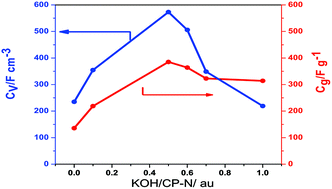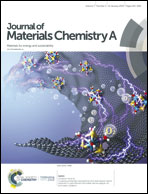Nitrogen-doped highly dense but porous carbon microspheres with ultrahigh volumetric capacitance and rate capability for supercapacitors†
Abstract
Well balancing two seemingly incompatible characteristics, a porous microstructure and a high density of carbon electrodes, for achieving both high gravimetric capacitance and high packing density is crucial to the realization of high volumetric capacitance performance but has proved to be very challenging to achieve. Here, we demonstrate an effective strategy based on KOH activation of nonporous nitrogen doped carbon microspheres (CM-N); highly dense (1.49 g cm−3) but porous CM-N were obtained with a high gravimetric capacitance of 385 F g−1, and therefore an ultrahigh volumetric capacitance of up to 573 F cm−3 in aqueous electrolytes, which is much higher than those of the existing carbon-based materials. More promisingly, the volumetric capacitance of the activated CM-N reaches an unprecedented value of 495 F cm−3 at a high current density of 20 A g−1, retaining 86.3% of its initial value measured at 0.2 A g−1, indicating an excellent rate capacitive performance. All these attractive features make this class of carbon materials promising for high performance supercapacitors in large-scale real-world applications.



 Please wait while we load your content...
Please wait while we load your content...